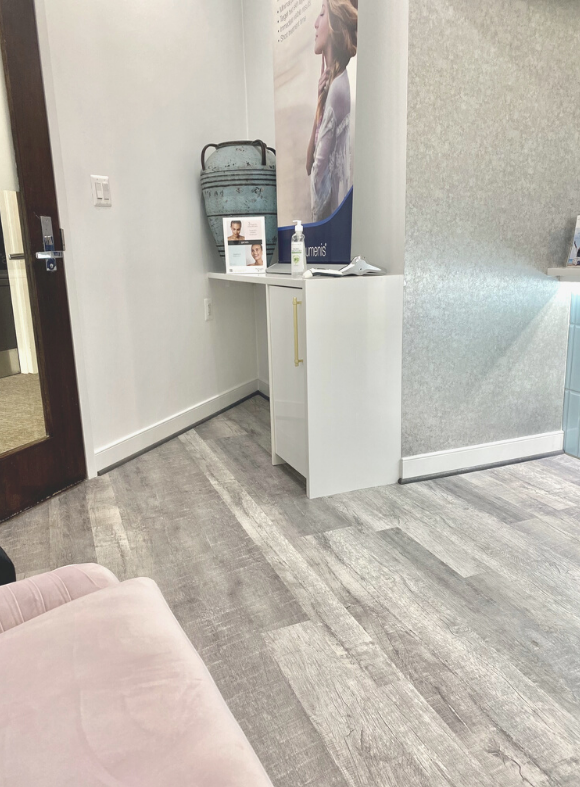welcome
Professional Microneedling
Treatment in Tysons Corner, VA
Transform Your Skin with Collagen Induction Therapy
What is Microneedling?
Microneedling, also known as collagen induction therapy, is a revolutionary minimally invasive cosmetic procedure designed to dramatically improve your skin’s appearance and texture. Our professional microneedling treatments in [Your City] use state-of-the-art devices equipped with ultra-fine, sterile needles to create precise, controlled micro-injuries in your skin’s surface.
These carefully controlled micro-punctures trigger your body’s natural healing response, stimulating increased production of collagen and elastin – the essential proteins responsible for maintaining your skin’s firmness, elasticity, and youthful appearance. Unlike more invasive procedures, microneedling works with your body’s natural regenerative processes to deliver outstanding results with minimal downtime.
At our Tysons Corner physician led women’s wellness institute spa, we enhance traditional microneedling with advanced serums and growth factors to maximize your treatment results and accelerate the healing process.
Proven Benefits of Professional Microneedling
Our professional microneedling treatments in Tysons Corner offer comprehensive skin rejuvenation with scientifically-proven results:
Stimulates Natural Collagen Production
Trigger your body's natural healing response to produce more collagen and elastin, resulting in firmer, more youthful-looking skin with improved elasticity and reduced signs of aging.
Dramatically Improves Skin Texture
Smooth out uneven skin texture, reduce the appearance of fine lines and wrinkles, and achieve a more refined, radiant complexion through enhanced cellular turnover.
Reduces Acne Scars Effectively
Particularly effective for treating acne scars, microneedling encourages skin repair and regeneration, significantly reducing scar visibility over a series of treatments.
Minimizes Enlarged Pores
Promote collagen production around pore walls to tighten and minimize the appearance of enlarged pores, creating a smoother, more refined skin texture.
Enhanced Product Absorption
The micro-channels created during treatment allow for superior absorption of specialized serums, growth factors, and skincare products, amplifying their therapeutic benefits.
Treats Hyperpigmentation
Effectively address uneven skin tone, age spots, and hyperpigmentation by promoting the shedding of pigmented cells and encouraging new, evenly-toned skin growth.
Our Professional Microneedling Process
Experience our comprehensive, medically-supervised microneedling treatment process in our state-of-the-art facilities in Tysons Corner, VA
1. Initial Consultation & Skin Analysis
Comprehensive skin assessment and customized treatment planning based on your specific concerns and goals.
2. Skin Preparation & Cleansing
Thorough cleansing and preparation of the treatment area with medical-grade antiseptic solutions.
3. Precision Microneedling Treatment
Our trained professionals use advanced pen-like devices with adjustable needle depths for optimal, comfortable treatment.
4. Advanced Serum Application
Application of specialized growth factors, peptides, or healing serums for enhanced results and accelerated recovery.
5. Post-Treatment Care & Recovery
Soothing treatment application and comprehensive aftercare instructions for optimal healing and results.
Optimal Treatment Schedule for Maximum Results
What is Microneedling?
Professional microneedling treatments are typically scheduled every 4-6 weeks to allow adequate time for your skin’s natural healing process and collagen stimulation cycle to progress effectively.
The exact frequency of your treatments will be customized based on:
- Your individual skin condition and concerns
- Specific treatment goals and desired outcomes
- Your skin’s response to previous treatments
- Overall skin health and healing capacity
Most patients in our Tysons Corner, VA practice begin seeing noticeable improvement after 2-3 sessions, with optimal results typically achieved after a complete series of 4-6 treatments. Our experienced team will create a personalized treatment plan to ensure you achieve your best possible results.
Enhanced Microneedling Treatment Options
Maximize your results with our advanced microneedling combinations, available exclusively at our Tysons Corner, VA Spa
BioRepeel + Microneedling
Pept DNA Infusion Cutting-edge treatment combining hyaluronic acid, DNA fragments, antioxidant glutathione, and healing peptides to restore optimal extracellular matrix function.
Pept DNA Infusion
Cutting-edge treatment combining hyaluronic acid, DNA fragments, antioxidant glutathione, and healing peptides to restore optimal extracellular matrix function.
PepFactor Enhancement
Powerful growth factor and peptide complex designed to amplify your skin's natural regenerative response and optimize treatment outcomes.
Anteage Exosome Therapy
Revolutionary exosome technology featuring DNA, peptides, and essential nutrients delivered directly to your skin for enhanced tissue repair and regeneration.
Safety & Suitability
Suitable for All Skin Types
Microneedling is considered safe and effective for all skin types (Fitzpatrick scale I-VI), making it an excellent choice for diverse patient populations. This versatile treatment can be safely combined with other advanced procedures including chemical peels, laser treatments, and platelet-rich plasma (PRP) therapy to enhance your results.
Important Contraindications
While microneedling is safe for most individuals, certain conditions require special consideration:
- Active skin infections: Treatment should be postponed until infections (cold sores, active acne) have completely cleared
- Severe cystic acne: Requires dermatologist consultation before treatment
- Pregnancy: Treatment is generally avoided during pregnancy as a precautionary measure
- Keloid scarring tendency: May require alternative treatment approaches
Essential Post-Treatment Care
Proper aftercare is crucial for maximizing your microneedling results and ensuring optimal healing:
Sun Protection Protocol
Apply broad-spectrum SPF 30+ sunscreen daily and avoid direct sun exposure for 48-72 hours post-treatment to prevent hyperpigmentation.
Gentle Cleansing Routine
Use only mild, non-irritating cleansers for the first 2-3 days. Avoid harsh exfoliants, scrubs, or retinol products during initial healing.
Optimal Hydration
Keep skin well-moisturized with gentle, fragrance-free moisturizers to support the healing process and maintain comfort.
Makeup Restrictions
Avoid applying makeup for at least 24 hours post-treatment to prevent potential irritation and reduce infection risk.
Experience the Luxury of no makeup days with Smooth Skin
Ready to Transform Your Skin in McLean, VA?
Experience the revolutionary Microneedling treatment at our state-of-the-art Fairfax medical spa. Our experienced professionals are ready to help you achieve your skincare goals..
FAQs
Have more questions?
Get in touch!
How long does a microneedling treatment take?
What should I expect during recovery?
When will I see results from microneedling?
Is microneedling painful?
How much does professional microneedling cost in McLean, VA?
Ready to Restore Your Confidence and Enhance Your Intimate Wellness?
Take the first step toward renewed confidence and enhanced intimacy. Schedule your confidential consultation to learn if O-Shot® is right for you.
At En Sante Med, we specialize in personalized solutions. Our certified professionals ensure top-quality care tailored to you. From initial consultations to aftercare, we’re with you every step.
- Location
- Expertise
- Now

CONTACT INFORMATION
Get In Touch!
En Santé Med
LOCATIONS:
1420 Spring Hill Rd, Suite 160, McLean Va, 22102
5225 Wisconsin Ave, Suite 200 Washington DC, 20015

Email: info@ensantemedicalspa.com
Call/TEXT: 703-888-8589
Which procedures are safe to perform with microneedling?
BioRepeel
BioRepeel is an excellent compliment to microneedling. Microneedling enhancing your bodies natural ability to heal repair and regenerate. BioRepeel enhances the process and also provides your body with the vital things it needs for repair such as amino acids such as proline and lysine, peptides and antioxidants.
Pept DNA
Pept DNA contains Hyaluronic acid, DNA fragments, antioxidant glutathione, and healing peptides.
It restores the physiological condition of the extracellular matrix to promote and improve the skin’s healing processes.
PepFactor
PepFactor contains peptides, growth factors
Anteage exosomes
Exosomes are extracellular vehicles made up of that look like small globules membranes that contain DNA, peptides and other important nutrients that are essential for tissue repair. Combining Exosomes to microneeding enhances the healing process.
